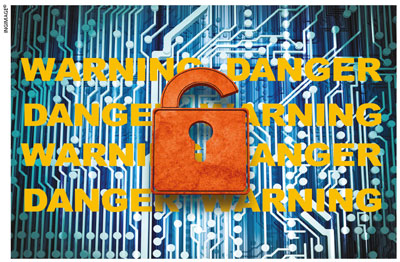BRAND MORPHOSIS
DISRUPTIVE ERA MARKETING
How to turn customers into brand advocates – Dr. Muneer Muhamed explains
Data privacy or not, everyone seems to think that not being on social media can make one irrelevant. Yet, even self-proclaimed digital wizards don’t really know what works and what doesn’t.
Technological changes are very rapid and leading brands are finding that interactions with consumers are being fundamentally challenged in the new digital age of disruption. The morphosis in branding is imminent if not initiated already.
It is less about advertising and more about basic marketing for the disruptive age. Consumers want help with their lives. The question is: ‘How do you organise yourselves to help them?’
Integrating into customers’ lives is less about advertising to them; it’s more about adding value to the experiences that they desire or choose. It is a constant peeling away of layers and becoming more comfortable with losing control of comfort zones. Today, no brand manager can claim that they’re in control of the brand.
Marketing is fairly simple. Finding insights is the hard part. Once you figure that out, things will begin to fall into place in this new age. The right idea is to talk with and not at consumers. You must have something with which people can interact and solve an issue they might be grappling with.
The digital revolution is changing the way brands communicate their message to consumers. Recent studies indicate that 79 percent of Twitter usage is on mobile devices while a third of search results for the world’s top 20 largest brands are linked to user generated content. About 42 percent of bloggers post opinions on products and brands.
So brands must understand that the conversation is happening in many different dimensions and areas. Observing and listening to these conversations is key to joining the group with value additions. You don’t have to be at the party anymore to ‘be at the party.’ But you need to stop going after audiences and pursue highly targeted groups of individuals instead.
Several brands have successfully used these principles to command ‘superbrand’ status in the new age. Starbucks for instance, is using its brand as the interface for content distribution. It has communities for activism, entrepreneurialism, good music and so on. The number one brand on Facebook for several years, Starbucks uses the channel to distribute information to add value to its conversations with customers.
Samsung and Coca-Cola are learning this game fast and becoming leading contenders in other rankings.
Sir Richard Branson’s Virgin is another global superbrand that transformed itself into a distribution facing brand. It’s now a space to build and incubate ideas. Branson launched a programme with the aim of inspiring others to make contributions that benefit the world. Individuals can pitch entrepreneurial ideas on video and become part of the Pitch TV show on Virgin airlines.
If we don’t learn from consumers, our brand is irrelevant in the digital space. The new age is fundamentally different in ways that are not always beneficial to big brands.
For example, the open environment of digital platforms increases the availability of information but erodes the advantages of big bucks brands. For a change, here you don’t own the shelves anymore. The social revolution also requires the coordination of marketing, sales and consumer relation functions that traditionally have never been in sync.
Even self-styled experts agree that they don’t know many things as evidenced from what they say, such as: ‘It is important to test and learn.’
Meeting objectives is more important than delivering perfect metrics. The metrics will be needed but the opportunities are not always effectively leveraged. Brands will have to evoke product and people stories. Transforming customers into fans and brand advocates is critical to a brand’s success on social media.
The following pointers are based on experience and are not like the self-proclaimed expert comments.
Clarify the rules of engagement. Which comments require a reply, which should be ignored and what is the basic etiquette when posting a response?
Who should be engaged and which target consumers or topics are most important to you (personally or your brand)?
Specify the chain of command. Who is in charge of the effort and responsible for implementation? A best practice is to create a flowchart that lists front line responders along with backups.
Structure should drive the tone of response. Corporate blogs are often criticised for being bland and uninteresting. Often, this stems from too much bureaucracy. By the time your response is posted, it’s been overly sanitised. A best practice is to have no more than two layers of approval and a turnaround time of less than a working day.
Establish transparency. The most successful corporate forays in social media operate at the highest levels of transparency whether in informing consumers about product launches or publicly admitting mistakes.






The tips given by the author to engage the customers in social media make great sense. This is probably the right advice for all of us who struggle in this area for building brands.
What emotions will undergo changes in social media? As marketers, do we have to change that fundamental assumption of universal truths? For example, don’t we all shed tears when we are really happy? Won’t school kids walk to school and run home? What has changed in this world today?
Driving brands, through their ideologies and insights, needs skills that go beyond the traditional 4Ps model. Kotler needs to revisit marketing in today’s world. Digital is not just about changing one or two ‘P’s.
The article provides some insights for both beginners and experienced marketers.
Well written. But economies, world over, seem sluggish and people are not worried about brands or branding, Sometimes there is absolutely no concern about brands. Poverty is also on the rise which is why people think of shirts and dresses of a particular brand as mere clothing rather than as a brand as such.
Indeed, no one seems wiser when it comes to social and digital media these days. Experimentation is the best way to develop intuition and drive what works for each brand.
Very true! Marketing is indeed simple, provided you can decipher the insights and learn from them. Great insightful article. Good read.